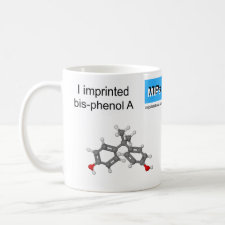
Authors: Wang ZH, Li YL, Li ZQ, Yan RY, Fu XY, Wang GS, Wang YM, Zhang XL, Hou JX
Article Title: The fabrication of molecularly imprinted polymer microspheres via Pickering emulsion polymerization stabilized with novel ferric hydroxide colloid.
Publication date: 2021
Journal: Reactive and Functional Polymers
Volume: 169
Article Number: 105084.
DOI: 10.1016/j.reactfunctpolym.2021.105084
Alternative URL: https://www.sciencedirect.com/science/article/pii/S1381514821002765
Abstract: In this paper, the ferric hydroxide colloid was prepared firstly, which was found suitable for the stabilizer of Pickering emulsion because of proper hydrophilicity. Then, molecularly imprinted polymers (MIPs) microspheres were synthesized by means of facile Pickering emulsion polymerization using ferric hydroxide colloid as emulsifier. In the synthesis process, hydrophilic methacrylic acid was used for the functional monomer, and ethylene glycol dimethacrylate served as the crosslinking agent. Bisphenol A (BPA), a typical endocrine-disrupting chemical, was used for the template molecules. The whole synthesis was based on the hydrogen bonds interaction between the functional monomer and template molecule. The ferric hydroxide colloid could be removed from the surface of microspheres by gentle washing. The morphology of obtained MIPs microspheres were assessed through the optical microscope and field emission scanning electron microscope, respectively. The results suggested that the MIPs appeared the regular spherical form with relatively wide size distribution, whose diameter varied from 10 to 60 μm. The adsorptive property was studied detailedly through a series of rebinding experiments. The research showed that MIPs have fast binding kinetics, whose rebinding equilibrium in tested concentration could be achieved within 60 min, and the rebinding capacity in 0.3 mmol L-1 of BPA initial solution is 8.19 μmol g-1. Additionally, the binding capacities of MIPs were larger than that of non-imprinted polymers in the batch equilibrium binding experiments. The binding selectivity was investigated with 4, 4'-biphenol and hydroquinone, which played the role of the structurally similar compounds of template molecules. The result showed that the MIPs were highly selective for BPA, and the imprinting factor was calculated to be 1.63. Reusability experiment indicates that our prepared MIPs have good mechanical stability and could be reused at least 5 times. The MIPs microspheres would be valuable in the field of environmental protection
Template and target information: bisphenol A, BPA
Author keywords: Pickering emulsion, Ferric hydroxide colloid, molecular imprinting, microsphere, bisphenol A



Join the Society for Molecular Imprinting

New items RSS feed
Sign-up for e-mail updates:
Choose between receiving an occasional newsletter or more frequent e-mail alerts.
Click here to go to the sign-up page.
Is your name elemental or peptidic? Enter your name and find out by clicking either of the buttons below!
Other products you may like:
 MIPdatabase
MIPdatabase









